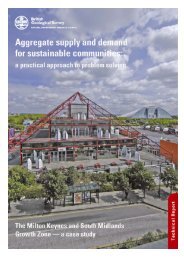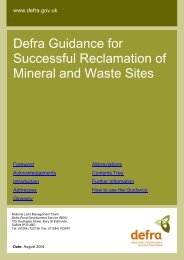creating environmental improvements through biodiversity
creating environmental improvements through biodiversity
creating environmental improvements through biodiversity
Create successful ePaper yourself
Turn your PDF publications into a flip-book with our unique Google optimized e-Paper software.
Cementia later went into partnership with Blue Circle PLC (UK). In 1989, Lafarge, the world’s largest building<br />
materials group, acquired Cementia and thus became an equal shareholder with Blue Circle. Lafarge bought<br />
Blue Circle in 2001 to become the largest building materials company in the world and Bamburi Cement<br />
Limited’s principal shareholder.<br />
In 2001, a company assessment concluded that many of the diverse farming activities were not economically<br />
sustainable due to rising costs of production. The original rehabilitation company Baobab Farm was<br />
restructured and some farm activities were outsourced, while others were transferred to the Baobab Trust<br />
and all were moved off site. One of the fish farm was maintained for educational and training demonstration<br />
and some crocodiles remain for their ecological functions in the water system and as a visitor attraction.<br />
The subsidiary company Baobab Farm was renamed Lafarge Eco Systems in 2004. This firm has set new<br />
objectives for the site to further develop capacity building for rehabilitation in order to transfer expertise to<br />
other Lafarge quarries in East Africa. Lafarge Eco Systems is concentrating on the ecological rehabilitation of<br />
quarries as one of its core activities.<br />
Lafarge Eco Systems currently employs 100 people full-time to manage and maintain the rehabilitation<br />
process as well as the different economic, <strong>environmental</strong> and social activities. The company hires seasonal<br />
labour and indirectly creates jobs by outsourcing key services, including landscape and plantation<br />
maintenance, seedling production, catering and sanitation.<br />
The rehabilitated parks are important landmarks in Kenya and attract over 100,000 visitors a year.<br />
Ecotourism now provides a major economic return for the rehabilitated sites.<br />
Sustainable Aggregates Creating Environmental Improvements <strong>through</strong> Biodiversity<br />
Current Rehabilitation Work<br />
Today Bamburi operates six quarries in Mombasa, three of which are next to the cement factory and three<br />
of which are 5–30 kilometres away. Five are limestone quarries and one is shale. Rehabilitation is ongoing in<br />
all six quarries.<br />
With the six operating quarries, the cement plant is projected to be in operation until 2050. The total<br />
quarry area is 900 hectares, and so far 200 hectares have been rehabilitated or are under rehabilitation.<br />
Rehabilitation activities are integrated with quarry operations, so that bare, open quarry areas are always<br />
minimal.<br />
Current rehabilitation techniques follow the same principles that were developed in the early years, in<br />
particular the use of Casuarinas to kick-start ecological recovery. The objective is to rehabilitate all the<br />
exhausted quarries to create diverse indigenous coastal habitats including wetlands, forests and grasslands.<br />
The older restored sites display a rich <strong>biodiversity</strong> of trees, lakes, water canals and wildlife, providing a unique<br />
contrast with the barren areas currently being quarried.<br />
The reclaimed north quarry areas have been developed as the Bamburi Forest Trails. These provide<br />
educational and recreational opportunities for walkers, joggers and cyclists. One of the trails features a<br />
butterfly-breeding house as an additional attraction for visitors. Fuelwood and timber sales, cycle rentals<br />
and catering facilities all provide additional economic returns. Future developments include a series of<br />
waterways interlinking lakes, ponds and wetlands and the further diversification of the forest with indigenous<br />
trees. Eventually each quarry is expected to stand alone as an economically self-sustaining unit <strong>through</strong><br />
multipurpose activities.<br />
Roles and Responsibilities<br />
The Bamburi Cement Company started production in 1954 and has grown to become the largest<br />
manufacturing export earner in Kenya. Today, Lafarge is the largest shareholder of the Bamburi Cement<br />
Company. Lafarge’s rehabilitation programmes in East Africa are all managed by Lafarge Eco Systems.<br />
113

















